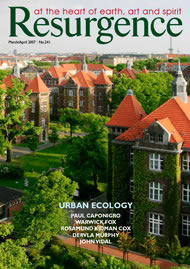FOR THE FIRST time a global consensus has emerged that we need to do something about global warming – something serious that will stop our planet from heating up to the point of total climatic, ecological and economic breakdown. This view has now penetrated to the heart of the British establishment as evidenced by the Stern Report, published by the UK Treasury last October.
There is just one problem. While there is widespread agreement that we need to do ‘something’, and that this something has to go a great deal further than anything the world has managed before, there is as yet little agreement as to just what that something ought to be.
So far, we have the 1992 United Nations Framework Convention on Climate Change (UNFCCC) and its Kyoto Protocol which gives industrial (Annex 1) countries targets to reduce their greenhouse-gas emissions to below 1990 levels by 2012 (accompanied by “flexibility mechanisms” which allow them to meet their targets by reducing emissions in less industrialised nations). Few would argue that the Kyoto Protocol has been a success – quite aside from the fact that the world’s biggest polluter, the USA, has yet to ratify it. Among its failings are the following:
It contains no global cap, so even if the unambitious targets set for Annex 1 countries to cut their emissions are met, overall emissions can carry on rising (as they have done).
The non-Annex 1 countries have no obligations at all to reduce or constrain emissions, and it is in such countries, notably China, India and Brazil, that emissions are rising fastest.
The flexibility mechanisms such as the Clean Development Mechanism often produce no demonstrable reductions in greenhouse-gas emissions. This is because, for example, a project to make a coal-fired power station in India more efficient might result in the station producing more electricity, rather than burning less coal, and might even make the power station more profitable, so allowing its owners to borrow the money to build additional power stations.
It is based on the idea of regulating greenhouse gases at the point of emission; however, this is an arbitrary choice – you could just as well regulate at the point of production of fossil fuels, or the point of consumption of end products (which would instantly transfer much of the emissions of China and India to the US, Japan and Europe).
The idea of regulating greenhouse gas emissions by country is inappropriate to the global economy in which energy, electricity and products that embody energy (and thus emissions) are freely traded across boundaries. Governments are also reluctant to commit to targets they may fail to achieve, or to tackle actions that are politically inexpedient.
When the Kyoto Protocol expires in 2012, we will need to move on to something significantly better, or we are all in trouble. The most important approach so far proposed is Contraction and Convergence (C&C), developed by Aubrey Meyer and his Global Commons Institute. Its key features are:
greenhouse-gas emissions should be subject to a contracting global cap;
rights to emit greenhouse gases should be allocated to countries based on their populations; and
greenhouse-gas emission rights should be tradable.
I have no argument at all with the ‘contraction’ aspect of C&C; indeed, it is essential. It is the ‘convergence’ part that doesn’t stack up. All that it really means is that non-industrialised countries that emit less than their
allocation of greenhouse gases receive a revenue stream in return, for their governments to spend as they choose. Even where this money is used well, it is unlikely to address the problems of climate change – reducing the emission of greenhouse gases and mitigating its impacts. This represents a missed opportunity.
SO WHAT WOULD Kyoto2 do differently? It would control fossil fuels at, or close to, the point of production, largely because fossil-fuel production sites are few in number and hence easily regulated. Thus fossil-fuel companies – the likes of Exxon-Mobil, BP, Shell, British Gas and British Coal – would have to buy fossil-carbon production rights to cover their production of oil, gas and coal. These rights would be issued up to an annual global ceiling based on IPCC (Intergovernmental Panel on Climate Change) recommendations, and sold at auction to secure their true economic value.
The country-based approach enshrined in the Kyoto Protocol, and in C&C, would be abandoned, at least for fossil carbon. Fossil-fuel consumers would pay their dues, not through some unfathomable and unreliable
carbon-accounting exercise, but through their share of the cost of the fossil-carbon rights passed on into products through the market. To ensure market efficiency, those rights would be freely tradable and could be carried over from year to year. An important benefit is that the auction of fossil-carbon rights would raise significant sums. The world currently emits over 25Gt (25 billion tonnes) of CO2 from fossil fuels each year. Based on a price of US$25/tCO2, the auction would produce some US$500 billion a year. This could be spent on, for example:
a Climate Impacts Mitigation and Adaptation Fund to help countries suffering severe climate change impacts such as flooding and drought – the similar fund agreed at the UNFCCC conference in Nairobi last November is projected to raise only US$1 billion over 10 years;
research into and development of low- or zero-carbon energy solutions, to wean the world away from its dependence on fossil fuels;
paying countries rich in forests, peatlands and other carboniferous biomes to preserve them and their biodiversity, and so reduce the 18% contribution to greenhouse-gas emissions that currently arises from forest burning;
helping governments to reduce non-fossil greenhouse-gas emissions within their territories, such as emissions of hydrofluorocarbons (HFCs) from refrigeration and air-conditioning, with particular emphasis on poor countries – note that by 2050 emissions from HFCs alone are expected to be responsible for 8.6% of all
global warming.
This still leaves the question of how to control non-fossil-fuel greenhouse-gas emissions: HFCs and potent industrial greenhouse gases (known as PIGGs) such as perfluorocarbons from aluminium smelting; CO2 from forest burning and concrete kilns; methane from agriculture, old coal mines and landfill sites; and the stratospheric pollution from aviation which trebles the radiative forcing of the CO2 alone.
The general principle should be to regulate such emissions at source where the sources are concentrated and identifiable, as with fossil fuels. This would apply, for example, to concrete manufacture, the use of aviation fuel by airlines, and the production of PIGGs. However, other gases, such as methane, which is emitted from numerous, varied and diffuse sources, would have to be controlled at a country level. The best model to apply in this instance is pure C&C, in which emissions rights are allocated to governments on a per capita of population basis. Those governments that keep national emissions within their allowances could sell surplus rights, equivalent to fossil-carbon production rights, into the market. Those that did not would need to buy rights to make up the shortfall.
So here, in a nutshell, is the Kyoto2 framework for a second Protocol to the UNFCCC. I believe it is practical, equitable and economically efficient, and offers a genuine prospect for the world to limit greenhouse-gas emissions and so bring climate change under control.
For more information please visit www.kyoto2.org.







